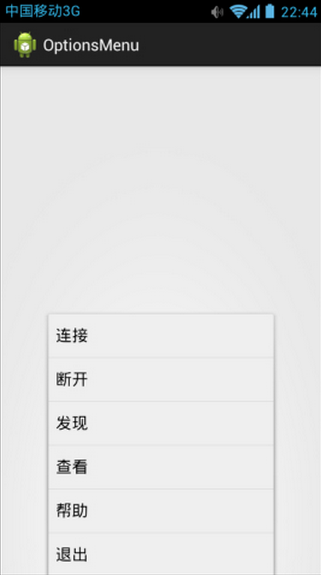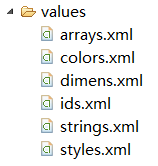Android資原始檔中各種XML的作用與解釋
阿新 • • 發佈:2019-01-04
眾所周知,XML是一種可擴充套件標記語言,它被用來傳輸和儲存資料。在Android中也會隨處可見XML檔案,包括一個android專案不可缺少的AndroidManifest.xml清單檔案,res資原始檔目錄下的anim/drawable/layout/menu/values中等,目錄截圖如下。其中清單檔案中內容最多最複雜,完全可以在其他文章中再來講解,所以本文主要講解res目錄下的XML的作用與內容。
一、anim目錄
anim目錄下的xml主要是用於android中的動畫,包括Frame animation(逐幀動畫)與Tween animation(補間動畫 )。1.逐幀動畫
逐幀動畫是一系列圖片按照一定的順序展示的過程,和放電影的機制很相似。可以理解成GIF,一幀一幀的顯示圖片。<animation-list>元素是必須的,並且必須要作為根元素,可以包含一或多個元素;android:onshot如果定義為true的話,此動畫只會執行一次,如果為false則一直迴圈;元素代表一幀動畫, android:drawable指定此幀動畫所對應的圖片資源;android:druation代表此幀持續的時間, 整數,單位為毫秒。<?xml version="1.0" encoding="utf-8"?> <animation-list xmlns:android="http://schemas.android.com/apk/res/android" android:oneshot="false"> <item android:drawable="@drawable/a_01" android:duration="50"/> <item android:drawable="@drawable/a_02" android:duration="50"/> <item android:drawable="@drawable/a_03" android:duration="50"/> <item android:drawable="@drawable/a_04" android:duration="50"/> <item android:drawable="@drawable/a_05" android:duration="50"/> <item android:drawable="@drawable/a_06" android:duration="50"/> </animation-list>
2. 補間動畫
補間動畫包括旋轉、 平移、縮放和透明度等效果。程式碼: ① 旋轉
<?xml version="1.0" encoding="utf-8"?> <set xmlns:android="http://schemas.android.com/apk/res/android" android:interpolator="@android:anim/accelerate_interpolator"> <!--fromDegrees:開始的角度 toDegrees: 結束的角度, +表示是正的 pivotX: 用於設定旋轉時的x軸座標 例 當值為"50",表示使用絕對位置定位 當值為"50%",表示使用相對於控制元件本身定位 當值為"50%p",表示使用相對於控制元件的父控制元件定位 pivotY: 用於設定旋轉時的y軸座標 --> <rotate android:fromDegrees="0" android:toDegrees="+360" android:pivotX="50%" android:pivotY="50%" android:duration="1000"/> </set>
② 平移
<?xml version="1.0" encoding="utf-8"?>
<set xmlns:android="http://schemas.android.com/apk/res/android"
android:interpolator="@android:anim/accelerate_interpolator">
<!--
始x軸座標
止x軸座標
始y軸座標
止y軸座標縮放
-->
<translate
android:fromXDelta="0%"
android:toXDelta="100%"
android:fromYDelta="0%"
android:toYDelta="100%"
android:duration="2000"/>
</set><?xml version="1.0" encoding="utf-8"?>
<set xmlns:android="http://schemas.android.com/apk/res/android"
android:interpolator="@android:anim/accelerate_interpolator">
<!--
起始x軸座標
止x軸座標
始y軸座標
止y軸座標
x軸的座標
y軸的座標
-->
<scale
android:fromXScale="1.0"
android:toXScale="0.0"
android:fromYScale="1.0"
android:toYScale="0.0"
android:pivotX="50%"
android:pivotY="50%"
android:duration="1000"/>
</set><?xml version="1.0" encoding="utf-8"?>
<set xmlns:android="http://schemas.android.com/apk/res/android"
android:interpolator="@android:anim/accelerate_interpolator">
<!-- fromAlpha和toAlpha是起始透明度和結束時透明度 -->
<alpha
android:fromAlpha="1.0"
android:toAlpha="0.0"
android:startOffset="500"
android:duration="500"/>
</set>二、drawable目錄
drawable目錄主要是為了定義圖片、按鈕的背景及其點選狀態。主要使用shape標籤和selector標籤。1.shape標籤
shape主要是定義一個形狀,然後可以設定給某個按鈕作為背景,最常用的就是圓角按鈕。程式碼:
<?xml version="1.0" encoding="utf-8"?>
<shape xmlns:android="http://schemas.android.com/apk/res/android"
android:shape=["rectangle"|"oval"|"line"|"ring"] >
<!-- 圓角 -->
<corners
android:radius="integer"
android:topLeftRadius="integer"
android:topRightRadius="integer"
android:bottomLeftRadius="integer"
android:bottomRightRadius="integer" />
<!-- 漸變 -->
<gradient
android:angle="integer"
android:centerX="integer"
android:centerY="integer"
android:centerColor="integer"
android:endColor="color"
android:gradientRadius="integer"
android:startColor="color"
android:type=["linear"|"radial"|"sweep"]
android:useLevel=["true"|"false"] />
<padding
android:left="integer"
android:top="integer"
android:right="integer"
android:bottom="integer" />
<size
android:width="integer"
android:height="integer" />
<solid
android:color="color" />
<!-- 描邊 -->
<stroke
android:width="integer"
android:color="color"
android:dashWidth="integer"
android:dashGap="integer" />
</shape>2.selector標籤
selector主要是定義不同狀態按鈕的背景等。程式碼:
<?xml version="1.0" encoding="utf-8" ?>
<selector xmlns:android="http://schemas.android.com/apk/res/android">
<!-- 預設時的背景圖片-->
<item android:drawable="@drawable/a_01" />
<!-- 沒有焦點時的背景圖片 -->
<item android:state_window_focused="false"
android:drawable="@drawable/a_01" />
<!-- 非觸控模式下獲得焦點並單擊時的背景圖片 -->
<item android:state_focused="true"
android:state_pressed="true"
android:drawable="@drawable/a_02" />
<!-- 觸控模式下單擊時的背景圖片-->
<item android:state_focused="false"
android:state_pressed="true"
android:drawable="@drawable/a_03" />
<!--選中時的圖片背景-->
<item android:state_selected="true"
android:drawable="@drawable/a_04" />
<!--獲得焦點時的圖片背景-->
<item android:state_focused="true"
android:drawable="@drawable/a_05" />
</selector>三、layout目錄
layout目錄主要存放android的佈局檔案,包括android中的五大布局:LinearLayout(線性佈局)、FrameLayout(幀佈局)、RelativeLayout(相對佈局)、AbsoluteLayout(絕對佈局)和TableLayout(表格佈局)。這裡就不在做詳細講解,相信大家在使用時也沒有太大問題。四、menu目錄
menu目錄主要用來存放選單的樣式,包括點選手機底部的選單鍵和頂部actionbar中設定的選單按鈕時的彈出框的選單項。 程式碼:<?xml version="1.0" encoding="utf-8"?>
<menu xmlns:android="http://schemas.android.com/apk/res/android">
<item android:id="@+id/connect"
android:orderInCategory="100"
android:showAsAction="never"
android:icon="@android:drawable/ic_menu_send"
android:title="連線" />
<item android:id="@+id/disconnect"
android:orderInCategory="100"
android:showAsAction="never"
android:icon="@android:drawable/ic_menu_close_clear_cancel"
android:title="斷開" />
<item android:id="@+id/search"
android:orderInCategory="100"
android:showAsAction="never"
android:icon="@android:drawable/ic_menu_search"
android:title="發現" />
<item android:id="@+id/view"
android:orderInCategory="100"
android:showAsAction="never"
android:icon="@android:drawable/ic_menu_view"
android:title="檢視" />
<item android:id="@+id/help"
android:orderInCategory="100"
android:showAsAction="never"
android:icon="@android:drawable/ic_menu_help"
android:title="幫助" />
<item android:id="@+id/exit"
android:orderInCategory="100"
android:showAsAction="never"
android:icon="@android:drawable/ic_menu_revert"
android:title="退出" />
</menu> 
五、values目錄
values目錄下的東西比較多,包括arrays.xml/colors.xml/dimens.xml/ids.xml/strings.xml/styles.xml,如下圖所示:
1.arrays.xml
arrays.xml檔案中用於放各種陣列資料,比如字串陣列、整型陣列等,陣列中的資料可能是具體的值,也有可能是對資源資料的引用。程式碼:
<?xml version="1.0" encoding="utf-8"?>
<resources>
<string-array name="select_items">
<item>one</item>
<item>two</item>
<item>three</item>
<item>four</item>
</string-array>
</resources>String[] items = getResources().getStringArray(R.array.select_items);2.colors.xml
colors.xml檔案中主要用來說明需要的顏色值,也可以在res目錄下另外新建一color資料夾用來存放這些xml檔案 程式碼:<?xml version="1.0" encoding="utf-8"?>
<resources>
<color name="red">#ff00000</color>
<color name="black">#000000</color>
<color name="white">#ffffff</color>
</resources>btn.setBackgroundColor(getResources().getColor(R.color.red));3.dimens.xml
dimens.xml用來定義控制元件的尺寸和文字的大小,在其中定義是為了方便做螢幕適配。 程式碼: <resources>
<!-- 控制元件的大小 -->
<dimen name="title_width">200dp</dimen>
<dimen name="title_height">50dp</dimen>
<!-- 字型的大小 -->
<dimen name="info_size">20sp</dimen>
<dimen name="tip_size">16sp</dimen>
</resources><TextView
android:layout_width="@dimen/title_width"
android:layout_height="@dimen/title_height"
android:textSize="@dimen/info_size"/>4.ids.xml
ids.xml為應用的相關資源提供唯一的資源id。 程式碼:<?xml version="1.0" encoding="utf-8"?>
<resources>
<item name="send" type="id"/>
<item name="public" type="id"/>
</resources><TextView
android:id="@id/send"
android:layout_width="@dimen/title_width"
android:layout_height="@dimen/title_height"
android:textSize="@dimen/info_size"/>5.strings.xml
Android建議將在螢幕上顯示的文字定義在strings.xml中,而且這樣做也可以做到國際化。程式碼:
<?xml version="1.0" encoding="utf-8"?>
<resources>
<string name="app_name">TestDemo</string>
<string name="action_add">新增</string>
<string name="action_del">刪除</string>
<string name="action_settings">設定</string>
<string name="action_about">關於</string>
<string name="action_suggest">建議反饋</string>
</resources><TextView
android:id="@id/send"
android:layout_width="@dimen/title_width"
android:layout_height="@dimen/title_height"
android:textSize="@dimen/info_size"
android:text="@string/action_add"/>6.styles.xml
styles.xml主要用來存放android的主題與樣式 程式碼:<resources>
<style name="myDialog" parent="@android:style/Theme.Dialog">
<item name="android:windowBackground">@color/transparent</item>
<!-- 設定dialog背景 -->
<item name="android:windowNoTitle">true</item>
<!-- 無標題 -->
<item name="android:windowIsFloating">true</item>
</style>
</resources>
